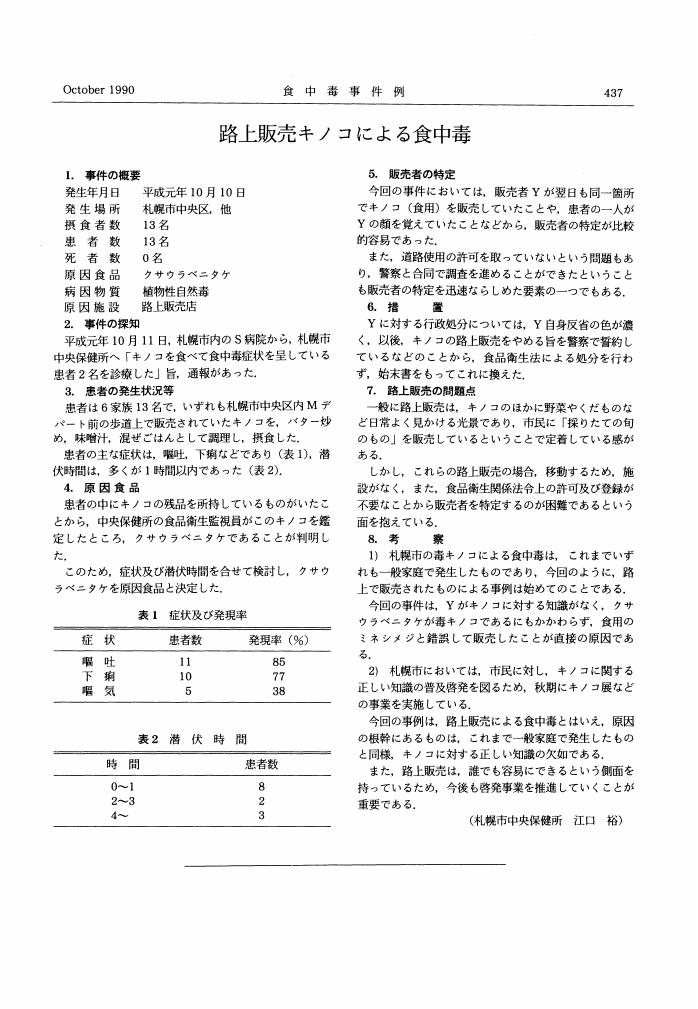1 0 0 0 路上販売キノコによる食中毒
- 著者
- 江口 裕
- 出版者
- 公益社団法人 日本食品衛生学会
- 雑誌
- 食品衛生学雑誌 (ISSN:00156426)
- 巻号頁・発行日
- vol.31, no.5, 1990
1 0 0 0 IR 芥川竜之介とエドガア・ポオ--鬼趣と鬼気について
- 著者
- 江口 裕子
- 出版者
- 東京女子大学
- 雑誌
- 東京女子大学附属比較文化研究所紀要 (ISSN:05638186)
- 巻号頁・発行日
- no.18, 1964-12
The present essay is a sequel to my previous one on Akutagawa and Poe, which dealt with their technique of short story writing. The purpose here is to investigate the nature of their common preference for the strange, the mystical and the bizarre as subjects, and to make clear the differences as well as the similarities between the two writers by analyzing some of their macabre writings. Both wrote of mystery, terror and strange fantasies. They were both deeply preoccupied with the mystery of human existence-death, life after death, madness and such psychological abnormalities as dual personality, hallucinations, obsessions and nightmares. From his early years, Akutagawa was fond of ghostly tales and was well acquainted with the writers of Gothic romances, of whom Poe was one. It was Akutagawa who first discovered and introduced to Japanese readers Ambrose Bierce, one of Poe's successors in America. It is not, therefore, surprising that Akutagawa seems to have been more or less indebted to the writers of the Gothic tradition for the mood of his writings. He customarily endeavored to write for a weird, thrilling effect, but meanwhile impressing his readers by the use of artistic verisimilitude. His earlier works, however, prove that he failed in his attempt to make them realistic and truly believable; they seem to be little more than products of his calculating intellect and craftmanship. On the contrary, the superiority of Poe's writings is not merely a matter of literary art, but of making a full use of his own inner experience to enrich his literary world. The secret of Poe's tales of mystery and terror lies in the excellent blending of his imagination and analytical faculty, a blending which enabled him to reach far into the abyss of the human mind in its conscious or subconscious conditions, and to present the tragic drama of the mind under such critical conditions, as for instance, the awareness of going mad. There is a powerful realism in his tales. No stock characters of the conventional Gothic romance-ghosts, witches, devils and vampires-appear; rather, in most cases, the plot, the characters and the situations all belong to real life, and terror is explored on the basis of human and realistic phenomena. When Poe adds artistic verisimilitude to this basic realism, his works are at their best. It was only in his later years, when Akutagawa confronted the gruesome reality of his own diseased mind and presented the states and processes of its disintegration as they really were, that he could write with impressiveness. In my opinion, Akutagawa rivaled Poe for the first time in Haguruma, where he too created the "terror of the soul" which was Poe's special province.
本研究の目的は、「フェロトーシス(Ferroptosis、鉄依存的細胞死)の分子機構」を明らかにして、加齢による生体機能の低下(=老化)に鉄が果たす役割を解明することである。 フェロトーシスは、鉄キレート剤によって阻害されることから、鉄依存的な「制御された細胞死(Regulated cell death:RCD)」であると定義されている。RCDは、生体恒常性を維持する上で非常に重要な機構で、老化との関連も深い。研究代表者らは、加齢に伴う鉄代謝異常が老化を促進する背景には、フェロトーシスが関与しているのではないかと考えている。しかしながら、どのような鉄代謝異常がフェロトーシスを引き起こすのかということは未だに明らかになっていない。これまでに、研究代表者らは、フェロトーシスが誘導される際に、細胞内の鉄量が増加していること、鉄代謝調節タンパク質IRP1が顕著に減少していることを見出している。 平成29年度には、培養細胞を用いて、フェロトーシスの誘導機構に関する検討を行った。その結果、これまでにフェロトーシスの誘導剤として知られていたErastin以外にも、酸化ストレスを誘導する薬剤によってフェロトーシスに類似した細胞死が誘導されることを見出した。また、二価鉄イオン特異的な蛍光プローブであるRhoNox-1などを用いて、Erastinや酸化ストレスによって細胞死が誘導される際の鉄イオン動態を解析した。
1 0 0 0 OA 路上販売キノコによる食中毒
- 著者
- 江口 裕
- 出版者
- 公益社団法人 日本食品衛生学会
- 雑誌
- 食品衛生学雑誌 (ISSN:00156426)
- 巻号頁・発行日
- vol.31, no.5, pp.437-437, 1990-10-05 (Released:2009-12-11)
1 0 0 0 OA LB培地及びアガロースのダイ・ターミネーター法によるDNAシークエンシングに及ぼす影響
- 著者
- 山口 幸洋 任張 幸子 小幡 博子 大河原 知水 江口 裕伸 黒津 敏嗣 鈴木 敬一郎
- 出版者
- 公益社団法人日本薬学会
- 雑誌
- 藥學雜誌 (ISSN:00316903)
- 巻号頁・発行日
- vol.122, no.7, pp.495-498, 2002-07-01
- 参考文献数
- 5
- 被引用文献数
- 1
The direct sequencing of PCR products, a bacterial colony (plasmid DNA), or a phage plaque (λDNA) is a very powerful technique in several molecular biological applications. Recently, we reported the successful application of this direct sequencing methodology, called recyclesequencing. Occasionally, however, our sequencing efforts failed due to the presence of agarose gel containing Luria-Bertani (LB) medium. Consequently, we pursued a semiquantitative investigation of the inhibitory effects of agarose and LB medium on the direct sequencing reaction. We found that LB medium concentrations greater than 26.7% inhibited the sequencing reaction. Furthermore, agarose concentrations greater than 0.20% in a reaction mixture also inhibited the sequencing reaction.

